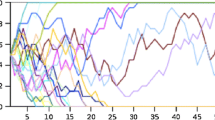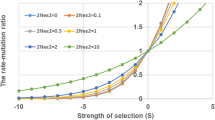Summary
Studies by computer simulation to determine applicability of the theory of the distribution of gene frequencies at the steady state of decay to small populations and the effect of linkage on the distribution revealed:
-
1.
For random genetic drift with no selection theory and observations agree well for independent assortment and linkage.
-
2.
For random genetic drift with selection theory and observations agree well for independent assortment and full dominance. Linkage with relatively large N s decreased the mean gene frequency of unfixed classes and the steady rate of fixation of the favorable allele.
-
3.
With independent assortment and additive gene effects agreement between theory and observations for the rates of fixation and loss at the terminal classes was good only for effective population number of at least 42. Small effective population numbers increased variance and decreased the steady rate of fixation and loss at the terminal classes.
Linkage had no effect for small N s, but for relatively large N s, it decreased the mean of gene frequencies and increased the steady rate of fixation and loss at the terminal classes from that of independent assortment.
Zusammenfassung
Simulationsexperimente am Computer zur Untersuchung der Anwendbarkeit der Theorie der Verteilung von Genfrequenzen mit einer stetigen Verfallsrate auf eine kleine Population unter Berücksichtigung des Einflusses der Koppelung auf die Verteilung ergaben:
-
1)
Bei zufälliger genetischer Drift ohne Selektion stimmen Theorie und Beobachtung sowohl für die Annahme freier Spaltung als auch für die der Koppelung gut überein.
-
2)
Bei zufälliger genetischer Drift mit Selektion stimmen Theorie und Beobachtung für die Annahme freier Spaltung und vollständiger Dominanz gut überein. Bei relativ großen Werten von N s reduziert Koppelung die mittlere Genfrequenz unfixierter Klassen und die stetige Fixierungsrate begünstigter Allele.
-
3)
Bei freier Spaltung und additiver Genwirkung war die Übereinstimmung zwischen Theorie und Beobachtung hinsichtlich der Fixierungsrate und des Verlustes in terminalen Klassen nur für eine effektive Populationsgröße von mindestens 42 Individien gut. Kleinere effektive Populationsgrößen steigern die Varianz und reduzieren sowohl die stetige Fixierungsrate als auch den Verlust in den terminalen Klassen. Bei kleinen Werten von N s hat Koppelung keine Wirkung, jedoch reduziert sie die mittlere Genfrequenz und erhöht die stetige Fixierungsrate und den Verlust in den terminalen Klassen im Vergleich zu freier Spaltung dann, wenn N s relativ groß ist.
Similar content being viewed by others
Literature cited
Bauer, F. L., H. Rutishauser and E. Stiefel: New aspects in numerical quadrature. Proceedings of Symposium in Applied Mathematics Vol. XV, 199–218 (1936).
Fisher, R. A.: On the dominance ratio. Proc. Roy. Soc. Edin. 42, 321–341 (1922).
Fisher, R. A.: The distribution of gene ratios for rare mutations. Proc. Roy. Soc. Edin. 50, 205–220 (1930).
Haldane, J. B. S.: A mathematical theory of natural and artificial selection. VII. Selection intensity as a function of mortalityrate. Proc. Camb. Phil. Soc. 27, 131–136 (1931).
Hill, W. G., and A. Robertson: The effect of linkage on limits to artificial selection. Genet. Res. 8, 269–294 (1966).
Kimura, M.: Solution of a process of random genetic drift with a continuous model. Proc. Nat. Acad. Sci. 41, 144–150 (1955a).
Kimura, M.: Stochastic Processes and distribution of gene frequencies under natural selection. Cold Spring Harbor Symp. 20, 33–53 (1955b).
Kimura, M.: Some problems of stochastic processes in genetics. Ann. Math. Stat. 28, 882–901 (1957).
Kimura, M.: Diffusion models in population genetics. Methuen's Review Series, Vol. 2. London: Methuen and Co. Ltd. 1964.
Kimura, M., and J. F. Crow: The measurement of effective population number. Evolution 17, 279–288 (1963).
Latter, B. D. H.: The interaction between effective population size and linkage intensity under artificial selection. Genet. Res. 7, 313–323 (1966).
Nassar, R. F., and R. E. Comstock: Simulation studies of the effects of linkage and selection on the probability of gene fixation in small populations. Biometrics 22, 954–955 [abstract] (1966).
Robertson, A.: The effect of inbreeding on the variation due to recessive genes. Genetics 37, 188–207 (1952).
Stratton, J. A., P. M. Morse, L. J. Chu, and R. A. Hunter: Elliptic cylinder and spheroidial wave functions. New York: John Wiley and Sons 1941.
Stratton, J. A., P. M. Morse, L. J. Chu, J. D. C. Little, and F. J. CorbatÓ: Spheroidal Wave Functions. New York: Technology Press of M.I.T. and John Wiley, 1956.
Wright, S.: Evolution in mendelian populations. Genetics 16, 97–159 (1931).
Author information
Authors and Affiliations
Additional information
Communicated by R.C. Lewontin, Chicago
Rights and permissions
About this article
Cite this article
Nassar, R.F. Distribution of gene frequencies under the case of random genetic drift with and without selection. Theoret. Appl. Genetics 39, 145–149 (1969). https://doi.org/10.1007/BF00272522
Received:
Issue Date:
DOI: https://doi.org/10.1007/BF00272522




